#Regina Corrado
Explore tagged Tumblr posts
Text

Mayor of Kingstown
Season 2, “Drones”
Director: Stephen Kay
DoP: Stuart Campbell
#Mayor of Kingstown#Drones#Mayor of Kingstown S02E07#Season 2#Stephen Kay#Stuart Campbell#Jeremy Renner#Mike McLusky#Necar Zadegan#Evelyn Foley#Regina Corrado#Taylor Sheridan#Hugh Dillon#Paramount+#MTV Entertainment Studios#Bosque Ranch Productions#101 Studios#Square Head Pictures#TV Moments#TV Series#TV Show#television#TV#TV Frames#cinematography#February 26#2023
8 notes
·
View notes
Text
Inaugurato nuovo reparto di Pneumologia al Regina Margherita
Al termine di 18 mesi di lavori, costati 3 milioni di euro e promossi da Fondazione Respiro Libero Onlus, con il sostegno di Compagnia di San Paolo nell’ambito del bando Hospeedal, è stato inaugurato oggi, il nuovo reparto di Pneumologia pediatrica Grazia e Corrado Tadolini dell’Ospedale Regina Margherita della Città della Salute di Torino. Si tratta di una struttura dedicata ai bisogni di…
View On WordPress
0 notes
Text
La bellezza e l'eleganza della Regina dello Splendore come risposta al caos della menzogna
In occasione della festa del Santissimo Nome di Maria, pubblichiamo un video editoriale del prof. Corrado Gnerre.
youtube
View On WordPress
1 note
·
View note
Text
I grandi marchi: Mediaset

Un mondo di telefilm, cartoni animati, show, quiz, eventi, legato alla figura di Silvio Berlusconi e oggi parte dell’immaginario collettivo degli italiani… La storia di Mediaset comincia nel 1976, quando Berlusconi era un imprenditore del settore edilizio e compro, da Giacomo Properzy, Telemilano, emittente via cavo, che aveva dei debiti anche nei confronti della Edilnord, una società immobiliare del Cavaliere. Telemilano trasmetteva i suoi programmi da un condominio di Milano 2, il primo grande progetto di Berlusconi, che si trova alle porte di Milano, per la precisione a Segrate, ed era stata fondata due anni prima, quando la Corte Costituzionale aveva permesso la creazione di televisioni private, purché trasmettessero a livello locale, decretando così la fine del monopolio televisivo della tv di Stato. Nel 1977 la proprietà della rete passò a Fininvest, che nel frattempo era diventata una società per azioni, e vennero trasmessi i programmi in Lombardia, e nel 1978 Telemilano divenne Canale 5. Anche se in Italia allora non era consentito trasmettere in diretta sul territorio nazionale, Berlusconi aggirò l’ostacolo con la creazione di un programma pre-registrato su una cassetta vhs che veniva spedita a decine e decine di emittenti sul territorio nazionale in modo da mandarlo in onda in contemporanea con gli stessi spot, senza che potessero così definirsi in diretta, che debuttò con il programma I sogni nel cassetto, gioco a premi televisivo condotto da Mike Bongiorno. Il Cavaliere capì però che per ampliare il mercato degli inserzionisti doveva raggiungere il grande pubblico e prima ottenne i diritti per la Copa de Ora, organizzata in Uruguay, alla Rai e poco dopo, sempre dalla tv di Stato, convinse a seguirlo nella nuova avventura nomi come Gigi Sabani, Corrado, ideatore di La corrida e Il pranzo è servito, Loretta Goggi, e la famosa coppia formata da Sandra Mondaini e Raimondo Vianello, con la sitcom di culto Casa Vianello, che sarebbe durata per ben sedici stagioni, dal 1988 al 2007. La scalata dell'imprenditore milanese prosegui nel 1982 con l'acquisto di Italia 1, che promosse la cultura degli anime giapponesi nella penisola, e nel 1984 con Rete 4, oltre all’arrivo di serie tv leggendarie come Dallas e Dynasty, che raccontavano il mondo dorato, tra scandali ed intrighi, dell’America degli anni Ottanta. Anche se alcuni nomi passati a Mediaset, come Pippo Baudo o Raffaella Carrà, sarebbero poi tornati alla Rai, Berlusconi era pronto anche per lanciare la sua visione del mondo dell’informazione, con a dirigere il primo Tg5 nel gennaio 1992 una personalità stimata come Enrico Mentana e un anno prima erano nati quello di Studio Aperto su Italia 1 e quello su Rete 4, diretto da Emilio Fede. Negli anni Novanta successi come Non è La Rai e Pressing, il contenitore sportivo di Italia 1 condotto da Raimondo Vianello, confermarono il successo crescente della rete, che divenne la grande avversaria della Rai. Il terzo millennio, oltre a trasformare Rete 4 in un contenitore di talk show serali molto seguiti e Italia Uno nella rete dei giovani, ha visto l’affermarsi di Canale 5 come la regina della fiction, oltre ad una serie di grandi eventi calcistici e di quiz amatissimi dal pubblico, come Chi vuol essere Milionario? Read the full article
1 note
·
View note
Photo
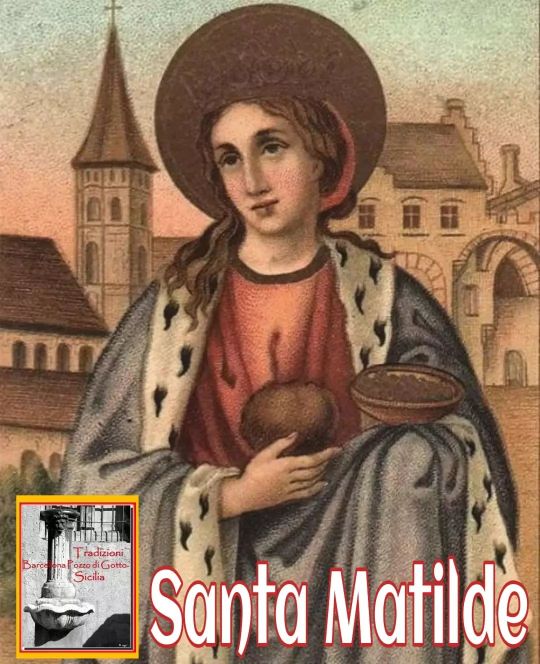
MARTEDI 14 MARZO 2023 - ♦️ SANTA MATILDE DI GERMANIA♦️ Matilde di Ringelheim (Enger, 895 circa – Quedlinburg, 14 marzo 968), fu la moglie di Enrico I l'Uccellatore e quindi duchessa consorte di Sassonia e poi regina dei Franchi Orientali. Madre dell'imperatore Ottone il Grande, dopo essere rimasta vedova divenne monaca nell'abbazia di Quedlinburg, da lei fondata; è venerata come santa dalle Chiese cattolica ed evangelica che ne celebrano la memoria il 14 marzo. Figlia del conte sassone di Vestfalia Teodorico di Ringelheim e di sua moglie Rinilde di Frisia[1], faceva dunque parte della dinastia degli Immedingi («proveniente dalla tribù di Widukindo»)[1][2]. Nacque attorno all'895 a Enger, in Vestfalia: la sua educazione venne affidata alla nonna, la badessa Matilde I, che la crebbe presso il suo monastero di Herford. il monastero aveva come abate laico Ottone l'Illustre, il quale scoprì Matilde. Rimase nell'abbazia fino al 909, quando i genitori la diedero in moglie al trentatreenne Enrico l'Uccellatore, figlio del duca di Sassonia Ottone l'Illustre, che la sposò quando lei aveva tredici anni a Wallhausen, aumentando la propria presenza e potere in Vestfalia[2]. Egli ripudiò conseguentemente la precedente moglie Hatheburga di Merseburgo, anch'ella suora prima di sposarsi e madre di Tankmaro. Enrico succedette al padre come duca di Sassonia nel 912 e nel 919, alla morte di Corrado I di Franconia, venne eletto re dei Franchi Orientali. Dal loro matrimonio nacquero cinque figli, tre maschi e due femmine: Ottone I di Sassonia, re dei Franchi Orientali dal 936, re degli Italici dal 951 e imperatore dei Romani dal 961; Gerberga, moglie di Luigi IV Oltremare, re dei Franchi Occidentali; Edvige, moglie di Ugo il Grande, conte di Parigi, e madre di Ugo I, fondatore della dinastia Capetingia; Enrico I, duca di Baviera; Bruno I il Grande, arcivescovo di Colonia e duca di Lotaringia. Durante il regno del marito si occupò delle opere di carità: fece erigere numerosi ospedali ed i monasteri di Quedlinburg, Pöhlde, Nordhausen, Grone (presso Gottinga) e Duderstadt[3]. Ella era rivale della nuora Edith[4]. Alla morte di Enrico (936) sostenne invano per la successione il figlio (presso Tradizioni Barcellona Pozzo di Gotto - Sicilia) https://www.instagram.com/p/CpxyfAXooD6/?igshid=NGJjMDIxMWI=
0 notes
Photo

SLYTHERIN:
"GEORGE HEARST: To labor without pleasure makes us our destiny's slaves. AL SWEARENGEN: To work for crumbs or to keep from the lash says maybe a slave's what you are."
–David Milch + Regina Corrado (Deadwood: I Am Not the Fine Man You Take Me For)
#harry potter#house quotes#slytherin#deadwood#george hearst#al swearengen#i am not the fine man you take me for#david milch#regina corrado#hphq
96 notes
·
View notes
Text
再戰奧斯卡!珍妮佛羅培茲主演「古柯鹼教母」傳記電影《The Godmother》有望由《使女的故事》女導演執導

每年的奧斯卡上總是幾家歡樂幾家愁,有人能開心抱回小金人,也當然有人只能空手而歸,可有些人甚至是連到現場感受盛典的機會都沒有。這些人並不是甚麼和奧斯卡八竿子打不著的路人,而是原本都幾乎已經可以準備禮服參加典禮的熱門人選,但卻意外的掉出了入圍名單,最終只能在家裡的沙發上看著冷冰冰的電視轉播。
每個獎項都不免會存在遺珠,不過奧斯卡這種每年從九月左右就開始「獎季」一直到隔年二月才結束的特殊模式,卻又會讓這些意外落馬的人顯得格外的殘念。在這獎季將近半年多的時間,每家影評人協會、工會和金球獎等大大小小的組織都會在奧斯卡之前陸陸續續開獎,頒出他們心中的最佳人選,且在這之中���往會出現一些高呼聲的領跑者,有極高的機會擠進奧斯卡的殿堂之中。
而在第 92 屆奧斯卡金像獎的獎季當中,依然存在不少遺珠之憾,包括在影評人協會中拿獎拿到手軟的《我們》Lupita Nyong’o、以《別告訴她》成為金球獎音樂/喜劇類電影影后的 Awkwafina 和在《原鑽》展現演技實力的喜劇明星 Adam Sandler 等人。雖說這些演員的傑出表現是有目共睹的,但背後仍有相當多「大人」的原因讓他們無法順利擠進奧斯卡,包括可能是不討喜的片型、一直以來爭論不休的種族弱勢或是片商公關不力等等,即使感到可惜但也不至於太過意外。可也有些演員,在獎季當中雖然並不是第一名的領跑著,但卻緊追在後,甚至一度追平到難分軒輊,外界都認為他要抱回小金人雖然有些困難,但入圍基本上已經是篤定的了,可最終卻跌破大家的眼鏡成為了超大遺珠。而在今年,這樣的人物也再一次的出現,他的名字也就是鼎鼎大名的「拉丁天后」Jennifer Lopez。
▼ 《舞孃騙很大》電影劇照

Jennifer Lopez 在 2019 年演出了自己同時擔任製片的《舞孃騙很大》,電影於多倫多影展首映後好評不斷,且在正式上映後也斬獲了相當亮眼的票房收益,不只成為了發行公司 STX Entertainment 最高票房的作品,也打破了 Jennifer Lopez 從影以來的最佳票房紀錄。除此之外,這次 Jennifer Lopez 在《舞孃騙很大》中飾演霸氣的紅牌脫衣舞孃,不只大秀高難度的鋼管舞技,更一反過往備受質疑的演技,展現了亦剛亦柔的角色深度,讓外界紛紛為其叫好,並被媒體稱之為「認真的奧斯卡競爭者」。而後,在接下來的奬季當中,Jennifer Lopez 果不其然的不斷的入圍「最佳女配角」的獎項,獲獎次數更一度追平領跑者《婚姻故事》的 Laura Dern,且接連入圍了金球獎和美國演員工會獎兩大指標獎。而正當外界認為 Jennifer Lopez 這次終於能夠揚眉吐氣受到奧斯卡的認可之時,卻在重要的「英國影藝學院電影獎」上落馬大傷氣勢,最終在奧斯卡上也跌破大家的眼鏡以高呼聲掉出最佳女配角的五強,成為了今年可說是最大的遺珠之一。
究竟 Jennifer Lopez 為什麼沒能夠順利入圍奧斯卡,在幾家媒體訪問具有投票資格的匿名會員訪談中也顯示出了一些蛛絲馬跡,包括有人認為《舞孃騙很大》並不是一部「奧斯卡電影」以至於不少會員並沒有看過此片,也有人對於 Jennifer Lopez 的「演員身份」保留態度等等。 而在奧斯卡典禮結束之後,Jennifer Lopez 也曾於訪談中表示有些受傷並且失望。此外,曾經與其論及婚嫁的《亞果出任務》奧斯卡最佳影片得主 Ben Affleck 也在訪談中為其抱屈,認為 Jennifer Lopez 值得入圍奧斯卡。
這回 Jennifer Lopez 雖然很可惜的沒能入圍奧斯卡,但他的演員之路當然不會因此而停止,或許在不久的未來他能夠一掃遺憾成功的擠身奧斯卡之中,而接下來這部電影可能就有那麼一絲絲的氣息了。
▼ 《舞孃騙很大》電影劇照

根���外媒指出,Jennifer Lopez 將演出一部傳記電影《The Godmother》,且在前日公布了電視劇《使女的故事》艾美獎最佳導演得主 Reed Morano 正在洽談掌舵導演大位的消息。攝影師出身的美國女導演 Reed Morano 近年以電視劇 《使女的故事》獲得影壇的矚目,其後導演的第二部電影長片《I Think We're Alone Now》更在日舞影展中拿下了「評審團特別獎暨傑出電影製作」。不過 Reed Morano 在今年執導由派拉蒙影業出品的高預算電影《The Rhythm Section》卻重摔了一跤,不只評價慘烈,票房更是慘上加慘,5000 萬美元的預算只獲得了 590 萬美元的票房。雖說如此,Reed Morano 仍是近年備受矚目的新銳女導演之一,也即將有機會執導這部電影新片《The Godmother》。
《The Godmother》原由電視劇《化外國度》的女編劇 Regina Corrado 和《華爾街之狼》的奧斯卡入圍男編劇 Terence Winter 攜手編寫,不過在最新的消息指出,曾經以《神鬼無間》獲得奧斯卡最佳改編劇本的 William Monahan 將會出任重編這部劇本。
《The Godmother》是一部取材自真人真事的傳記電影,將以被稱為「古柯鹼教母」的哥倫比亞女毒梟 Griselda Blanco 做為電影主角。講起南美洲的毒梟,你一定聽過 Pablo Escobar 或 El Chapo,至今有《毒梟》和《毒梟矮子》等相當多的影視作品都在拍他們的爭議人生。但在他們之前,有一位更是惡名昭彰的毒品女帝早已打造出他的毒梟帝國,而他的名字也就是 Griselda Blanco。 Griselda Blanco 在 40 年代出身於哥倫比亞的貧民窟,從小過著遭受母親施虐與其男友性侵的悲苦童年,貧困的家庭環境迫使他必須以犯罪與賣身謀生,並在最終逃離了家中。然而,過往悲慘的遭遇在他身上留下陰影,也間接的養成了他殘暴的性格,並開始一步步邁向了他所打造的毒品王國。Griselda Blanco 是歷史上最大的毒梟之一,據悉身價超過 20 億美元,且他更是 70 至 80 年代間發生於美國邁阿密血腥的「古柯鹼牛仔戰爭」中的關鍵人物。而這回,Jennifer Lopez 也將在電影當中飾演這位擁有爭議一生的古柯鹼女王。
▼ 《古柯鹼教母》電影劇照

恰巧的是,Griselda Blanco 的故事在 2017 年才剛被搬上美國的小螢幕一次。當時由 Lifetime 出品的電視電影《古柯鹼教母》找來了《芝加哥》奧斯卡得主 Catherine Zeta-Jones 詮釋 Griselda Blanco,並由墨西哥出生的《羊男的迷宮》金獎攝影師 Guillermo Navarro 執導。不過可惜《古柯鹼教母》並沒有獲得太多好評和討論,電影也就這樣默默的過去了。
事實上,《The Godmother》這個項目已經籌備多年,最早在 2016 年是計畫由 HBO 開發的電視電影,且早早確定將由身兼製作人的 Jennifer Lopez 親自飾演女主角 Griselda Blanco。不過在 2019 年時,這項計畫轉交至了 STX Entertainment 的手上,並且將由小螢幕轉戰大銀幕,不過幕後的製作團隊還是一直維持不變。包括 Jennifer Lopez 和 Benny Medina 將以其共同創辦的電影公司「Nuyorican Productions」來製作此片,而這也是他們繼《她的成功日記》和《舞孃騙很大》後第三度與 STX 攜手合作。此外,還有同為 Nuyorican Productions 總監之一的《舞孃騙很大》女製片 Elaine Goldsmith-Thomas 以及曾以《赴湯蹈火》入圍奧斯卡最佳影片的女製片 Julie Yorn 也都會出任該片的製作人之職。有趣的是,近來積極從事幕後製作工作的《舞棍俱樂部》的帥氣男星 Alex Pettyfer 也早從 2016 年就確定將擔任此片的監製之一。
《The Godmother》目前仍處於前製階段,除了 Jennifer Lopez 以外也尚未有其他演員參演的消息釋出。而目前正值全球的新冠肺炎(武漢肺炎)疫情高峰,在短時間內電影也無法正式開拍,檔期因此也都尚未定案。
▼ 《她的成功日記》電影劇照

#the godmother#jennifer lopez#alex pettyfer#griselda blanco#benny medina#elaine goldsmith-thomas#julie yorn#william monahan#regina corrado#terence winter#stx entertainment
0 notes
Text
y'all, DROP EVERYTHING AND LISTEN TO THIS ALBUM IT IS EVERYTHING
#opera#opera tag#IT’S OUT!!!#recital album#Amici e Rivali#Rossini#Gioachino Rossini#Lawrence Brownlee#Michael Spyres#Tara Erraught#Xabier Anduaga#Corrado Rovaris#I Virtuosi Italiani#Il barbiere di Siviglia#Otello#Le siège de Corinthe#La donna del lago#Ricciardo e Zoraide#Elisabetta regina d’Inghilterra#Armida#The Barber of Seville#The Siege of Corinth#The Lady of the Lake#Spotify
3 notes
·
View notes
Text


« What’s Woodstock? Jesus! »
Caprice, Tulsa King, 1.03
Ben Richardson (D), Regina Corrado (S), 27/11/22
31 notes
·
View notes
Text

Mayor of Kingstown
Season 2, “Little Green Ant”
Director: Stephen Kay
DoP: Stuart Campbell
#Mayor of Kingstown#Little Green Ant#Season Finale#Mayor of Kingstown S02E10#Season 2#Stephen Kay#Stuart Campbell#Jeremy Renner#Mike McLusky#Hugh Dillon#Ian Ferguson#Taylor Handley#Kyle McLusky#Regina Corrado#Dave Erickson#Taylor Sheridan#Paramount+#MTV Entertainment Studios#Bosque Ranch Productions#101 Studios#Square Head Pictures#TV Moments#TV Series#TV Show#television#TV#TV Frames#cinematography#March 19#2023
4 notes
·
View notes
Text
Guillermo del Toro's Cabinet of Curiosities
Lot 36
Teleplay by Regina Corrado and Guillermo del Toro
Based on a Short Story by Guillermo del Toro
Directed by Guillermo Navarro
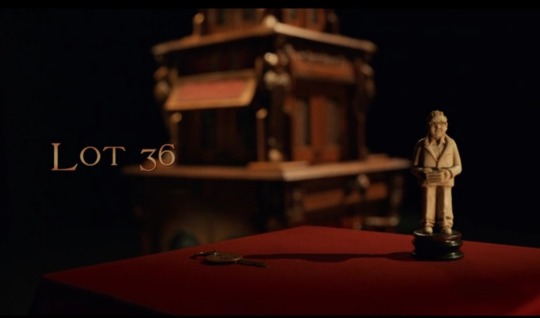
Lot 36 is a good episode to begin an anthology series helmed by del Toro. It has the creepy yet curious nature that is almost synonymous with the auteur. Although Navarro is better known as a cinematographer, his experience as a television director shone through with the pacing and overall storytelling.
Although the story itself felt cliché—a down on his luck right-wing veteran gets screwed over by his own actions—the use of an almost claustrophobic setting, the inclusion of a demonic ritual, and the cinematic production contributed to an exciting first episode. Additionally, the beautiful set designs and liberal use of practical effects set Lot 36 apart from the media we've grown accustomed to these past few years.
The actors also did a wonderful job, specifically Tim Blake Nelson. While his character was far from likeable, his presence on screen made it that you couldn't take your eyes off him. As you watch him go about his day, you want to know what horrible fate would befall him.
Rating: 4/5
The Graveyard Rats
Teleplay by Vincenzo Natali
Based on a Short Story by Henry Kuttner
Directed by Vincenzo Natali
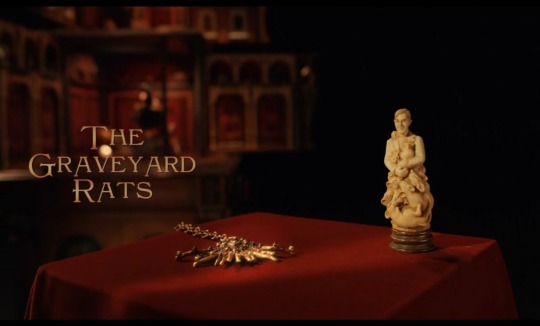
The Graveyard Rats, if I'm being honest, took me off-guard. I'm unsure if this was Natali's intention, but there was something comedic about. This isn't meant to be an insult. Rather, I found the levity in this episode pleasant, especially right after watching the first. It's good as a second episode because it keeps the viewers on their toes for the rest of the series.
Natali, much like del Toro, is known for sci-fi and horror. The latter of which is shown in full display here. It takes a lot to unnerve me but even I shuddered at all of the gluttonous rats that appeared on screen. From the thousands that fell on Masson (David Hewlett) to the human-sized abomination under the graveyard, this type of horror creature(s) is rare these days.
Story aside (although it's a good story), the set design was what really captured my attention. I absolutely loved the scene in the mortuary, specifically when the widower and her son were walking past the cadavers. Masson's apartment was also beautiful, with his personality showing through in every set piece. And the graveyard! Or should I say the hidden world underneath it... What I liked most about it was that it made me feel trapped and desperate for escape, something hard to capture and even harder to convey via screen.
Rating: 3.5/5
The Autopsy
Teleplay by David S. Goyer
Based on the Short Story by Michael Shea
Directed by David Prior

The Autopsy has the best dialogue, so far. Maybe because it was written by Goyer or maybe because F. Murray Abraham, Glynn Turman, and Luke Roberts had excellent deliver, either way it made the story more compelling. You could feel each of the characters' motivation behind their words, creating an emotional connection that makes the events of the episode better felt.
I also enjoyed this episode because of how cinematic it was. To misquote Harry Styles, "It felt like a movie." From the picturesque shots of the small mining town to the angles chosen to present the autopsy, all of it added to the overall production value of the episode. Although I'm unfamiliar with Prior's works, The Autopsy made me curious to check out his filmography.
Additionally, I'm usually not a fan of alien parasite storylines because they tend to be redundant. This was nice though. I liked the mystery aspect of it, especially since it felt like the audience was invited to join in on solving it. I also like the horror elements sprinkled throughout, from the eerie almost haunted feel of the makeshift mortuary to the disembodied voice warning Dr. Winters (Abraham) to get out. Overall, this was an enjoyable episode.
Rating: 4.5/5
2 notes
·
View notes
Text

- E lo princep respos al almirall: -Ques aço que vos volets que yo hi faça? que si fer yo puch , -volenters ho fare.- Yo , dix lalmirall , quem façats ades venir la filla del rey Manfre, germana de madona la regina Darago, que vos tenits en vostra preso aci el castell del Hou , ab aquelles dones e donzelles qui soes bi sien ; e quem façats lo castell e la vila Discle retre . - E lo princep respos , queu faria volenters. E tantost trames un seu cavaller en terra ab un leny armat, e amena madona la infanta , germana de madona la regina , ab quatre donzelles e dues dones viudes. E lalmirall reebe les ab gran goig e ab gran alegre , e ajenollas, e besa la ma a madona la infanta.
Ramon Muntaner, CRÓNICA CATALANA, p. 221
Beatrice was born (probably) in Palermo around 1260. She was the first child and only daughter of Manfredi I of Sicily and his second wife, the Epirote princess Helena Angelina Doukaina (“[…] et idem helenam despoti regis emathie filiam sibi matrimonialiter coppulavit, ex quibus nata fuit Beatrix.”, Bartholomaeus de Neocastro, Historia Sicula, in Giuseppe Del Re, Cronisti e Scrittori sincroni Napoletani editi ed inediti, p. 419). It’s quite plausible the baby had been named after Manfredi’s first wife, Beatrice of Savoy (mother of Costanza, who will later become Queen consort of Aragon and co-regnant of Sicily). The little princess would soon be followed by three brothers: Enrico, Federico and Enzo (also called Anselmo or Azzolino). With three sons, Manfredi must have thought his succession was secured.
Beatrice’s father was one Federico II of Sicily’s many illegitimate children, although born from his most beloved mistress (and possibly fourth and last wife), Bianca Lancia. Since his father’s death in 1250, Manfredi had governed the Kingdom of Sicily on behalf firstly of his (legitimate) half-brother Corrado and, after his death in 1254, of Corrado’s son, Corradino. In 1258, two years prior Beatrice’s birth, Manfredi had been crowned King of Sicily in Palermo’s Cathedral, de facto usurping his half-nephew’s rights.
Like it had happened with Federico, Manfredi was soon opposed by the Papacy, which didn’t approve of the Hohenstaufen’s rule over Sicily (and Southern Italy with it) and the role of the King as the champion of the Ghibellines faction. In 1263, Urban VI managed to convince Charles of Anjou, younger brother of Louis IX the Saint, to present himself as a contender to the Sicilian throne. Three years later, on January 6th 1266, the French duke was crowned King of Sicily by the Pope in Rome, thus overthrowing Manfredi. On February 26th, in Benevento, the usurped King then tried to get back his kingdom by facing Charles in the open field, but failed and lost his life while fighting.
The now widowed Queen Helena had previously fled to Lucera (in Apulia) with her children (Beatrice was now six), her sister-in-law Costanza, and her step-daughter, the illegitimate Flordelis, where she thought they would be safer. When they got news of the disaster of Benevento and Manfredi’s death, they fled to Trani from where they planned to set off to Epirus. The unfortunate party was instead betrayed and handed off to the Angevin. On March 6th night, Helena and the children were taken hostage and later separated. The Queen was sent at first to Lagopesole (in Basilicata) and finally to Nocera Christianorum (now Nocera Inferiore), where she would die still in captivity in 1271.
Enrico, Federico and Enzo were taken to Castel del Monte. Following Corradino’s death in 1268, Manfredi’s young sons (the oldest, Enrico, was just four at the time of his capture) were, to all effects, the rightful heirs to the Sicilian throne. It’s undoubtful Charles must have wanted them gone, or at least forgotten. In 1300 they were moved to Naples, in Castel dell’Ovo (which, at that time, was called San Salvatore a mare), under the order of the new Angevin king, Charles II. According to some sources, Federico and Enzo died there within the short span of a year. As for Enrico, he died alone and miserable in October 1318, he was 56.
As for Beatrice, her fate was more merciful compared to that of her mother and brothers and, for that, she had to thank her sex, which made her harmless in Charles’ eyes (as long as she was left unmarried). After being separated from her family (she will never see them again), the six years old princess was, like her brothers, held captive (although not together) in Castel del Monte. In 1271, she was moved to Naples, in Castel dell’Ovo, under the guardianship of its keeper, a French nobleman called either Landolfo or Radolfo Ytolant. Manfredi’s daughter is mentioned in a rescript of Charles dated March 5th 1272, from which we learn she had been granted at least a maid (“V Marcii xv indictionis. Neapoli. Scriptum est Iustitiario et erario Terre laboris etc. Cum ex computo facto per magistrum rationalem Nicolaum Buccellum etc. cum Landulfo milite castellano castri nostri Salvatoris ad mare de Neapoli pro expensis filie quondam Manfridi Principis Tarentini et damicelle sue. ac filie quondam comitis Iordani et damicelle sue dicto castellano in unc. auri novem et taren. sex de pecunia presentis generalis subventionis residuorum quolibet vel qua canque alia etc. persolvatis. non obstante etc. Recepturus etc.”, Monumenti n. XLIV. in Domenico Forges Davanzati, Dissertazione sulla seconda moglie del re Manfredi e su’ loro figliuoli, p. XLIII-XLIV). Like it had happened with her mother, and unlike her brothers, it appears Beatrice was treated with courtesy and respect. In her misfortune, she could count on the company of a fellow prisoner and distant relative, the daughter of Giordano Lancia d’Agliano, who was her grandmother Bianca Lancia’s cousin and had been a loyal supporter of her father, Manfredi.
On Easter Day of 1282, an anti-Angevin rebellion sparkled in Palermo would soon transform itself into a war to get rid of the so much hated Frenchmen, the so-called War of the Sicilian Vespers. It’s dubious that, close in her prison, Beatrice came to know about it. She might have also been surprised to know that her half-sister, Costanza, had been asked by a delegation of fellow Sicilians to take possession of what was hers by right (the throne) as she was their “naturalis domina”. Her rights were shared with her husband, Pedro III of Aragon, who would personally take part in the war and be rewarded with a joint coronation in November 1282.
For Beatrice, everything changed in 1284. On June 4th, Italian Admiral Ruggero di Lauria, at the service of the Aragonese King (he was also Costanza’s milk brother), defeated the Angevin fleet just offshore from Naples and took Carlo II prisoner. Being in clear superiority, the Sicilians could now demand (among many requests) the release of Princess Beatrice. Carlo’s eldest son and heir, Carlo Martello Prince of Salerno, could nothing other than obliging them. (“Siciliani autem , & omnes faventes Petro Aragonum, incontinenti de ipsorum victoria plurimum exultantes, Nuncios, & Legatos ad quoddam Castrum ex parte Principis direxerunt , ubi quaedam filia quondam Domini Regis Manfredi sub custodia tenebatur , ut dicta filia fine ullo remedio laxaretur , quae statim fuit antedictis Legatis , & Nunciis restituta.”, Anonimo Regiense, Memoriale Potestatum Regiensium. Gestorumque iis Temporibus. Ab anno 1154 usque ad Annum 1290, in Ludovico Antonio Muratori, Rerum Italicarum scriptores ab anno aerae christianae quingentesimo ad millesimumquingentesimum, vol. VIII, p. 1158).
Beatrice, finally free, left Castel dell’Ovo headed for Capri, where the Admiral was waiting for her. She had spent 18 long years in captivity and was now 24. From Capri she reached Sicily, where she was warmly welcomed and with a lot of enthusiasm, to meet her half-sister Costanza.
As the Queen’s closest free relative (both Pedro and Costanza had no interest in asking for Enrico’s release since, as a male, he had more rights than Costanza to inherit the throne), Beatrice had a great political value. At first, Ranieri Della Gherardesca’s name came up. He was the son of that Count Gherardo who had fought together with the unfortunate Corradino (the sisters’ royal cousin), and for that had been beheaded in Naples in 1268 alongside his liege. Finally the perfect candidate was found. Manfredo of Saluzzo was born in 1262 and was the son of Marquis Tommaso I and his wife Luigia of Ceva. Like Beatrice, Manfredo was strongly related to Costanza, specifically, he was her nephew since Tommaso and the Sicilian Queen were half-siblings (they were both Beatrice of Savoy’s children).
The marriage contract between the two is dated July 3rd 1286 and the contracting parties are on one side “la serenissima signora constanza regina dy aragon e dy sicilia e dil ducato de puglia principato di capua” and, on the other side “il marchexe thomas di sa lucio signore de conio una cum mạdona alexia soa moglie”. Tommaso declares that Manfredi will inherit his title, privileges and possession upon his death. If, after the marriage is celebrated, Manfredi were to die first, Beatrice would enjoy possession of the castle and some properties. The Marquise Luisa declares to agree with her husband’s decision (“[…] e a tuto questo la marchexa aloysia madre dy manfredo consenty”, Gioffredo Della Chiesa, Cronaca di Saluzzo, p. 165-166). The union was formally celebrated the year after.
Beatrice bore Manfredi two children: Caterina and Federico, born presumably in 1287 (“Et da questa beatrix haue uno figlolo chiamato fredericho et una figlola chiamata Kterina” Gioffredo Della Chiesa, Cronaca di Saluzzo, p. 185). In 1296 Tommaso died, so Manfredi inherited the marquisate and Beatrice became Marquise consort of Saluzzo. She will die eleven years later at 47, on November 19th 1307 (“Venne a morte nel dì 19 novembre di quest’anno Beatrice di Sicilia moglie del nostro marchese Manfredo, e noi ne accertiamo il segnato giorno col mezzo del rituale del monastero di Revello , nel quale leggesi annotato: 19 novembris anniversarium d. Beatricis filiae quondam d. Manfredi regis Ceciliae et uxoris d. Manfredi primogeniti d. Thomae marchionis Saluciarum, quae huic monasterio quingen- tas untias in suo testamento legavit.” Delfino Muletti, Memorie storico-diplomatiche appartenenti alla città ed ai marchesi di Saluzzo, vol III, p. 76). Her husband would quickly remarry with Isabella Doria, daughter of Genoese patricians Bernabò Doria and Eleonora Fieschi. Isabella would give birth to five more children: Manfredi, Bonifacio, Teodoro, Violante and Eleonora.
As of Beatrice’s children, Caterina would marry Guglielmo Enganna, Lord of Barge (“Catherina figlola dy manfredo e de la prima moglie fu sorella dy padre e dy madre dy fede rico e fu moglie duno missere gulielmo ingana capo dy parte gebellina in questy cartiery dil pie monty verso bargie.”, Gioffredo Della Chiesa, Cronaca di Saluzzo, p. 256). Federico’s fate would be more complicated. Like many mothers before and after her, Isabella Doria wished to see her own firstborn, Manfredi, succeeded his father rather than her step-son. The new Marchioness of Saluzzo successfully instigated her husband against his son to the point the Marquis. in a donatio mortis causa dated 1325, disinherited Federico in favour of the second son (Federico would have settled with just his late mother’s belongings), Manfredi (“Et questo faceua a instigatione de la moglie che lo infestaua a cossi fare.” Gioffredo Della Chiesa, Cronaca di Saluzzo, p. 224). Federico’s natural rights were later acknowledged by an arbitral award proclaimed in 1329 by his paternal uncles Giovanni and Giorgio of Saluzzo, and finally, an arbitration verdict dated 1334 and issued by Guglielmo Earl of Biandrate and Aimone of Savoy. As a condition of peace, the future Marquis should have granted his younger brother the castle and villa of Cardè as a fief. Stung by this defeat, Manfredi IV, his wife Isabella and beloved son Manfredi retired to Cortemilla. Federico died in 1336 and was succeeded by his son Tommaso, who would inherit his father’s rights and feud with the two Manfredi's. After being defeated by his half-uncle in 1341 (the older Manfredi, his grandfather, had died the year before), resulting in losing his titles, possessions and freedom, Tommaso would later regain what was of his right and rule as Marquis of Saluzzo.
Sources
-ANONIMO REGIENSE, Memoriale Potestatum Regiensium. Gestorumque iis Temporibus. Ab anno 1154 usque ad Annum 1290, in Ludovico Antonio Muratori, Rerum Italicarum scriptores ab anno aerae christianae quingentesimo ad millesimumquingentesimum, vol. VIII
-BARTHOLOMAEUS DE NEOCASTRO, Historia Sicula, in Giuseppe Del Re, Cronisti e Scrittori sincroni Napoletani editi ed inediti
- DEL GIUDICE GIUSEPPE, La famiglia di Re Manfredi
- DELLA CHIESA, GIOFFREDO, Cronaca di Saluzzo
-FORGES DAVANZATI, DOMENICO, Dissertazione sulla seconda moglie del re Manfredi e su’ loro figliuoli
- LANCIA, MANFREDI, Il complicato matrimonio di Beatrice di Sicilia
-Monferrato. Saluzzo
-MULETTI, DELFINO, Memorie storico-diplomatiche appartenenti alla città ed ai marchesi di Saluzzo, vol II-III
- MUNTANER, RAMON, Crónica catalana
- SABA MALASPINA, Rerum Sicularum
- SAVIO, CARLO FEDELE, Cardè. Cenni storici (1207-1922)
-Sicily/Naples: Counts & Kings
#women#history#women in history#historical women#history of women#beatrice of sicily#manfredi i#helena angelina doukaina#costanza ii#manfredi iv of saluzzo#federico of saluzzo#caterina of saluzzo#House of Hohenstaufen#norman swabian sicily#aragonese-spanish sicily#house of saluzzo#people of sicily#women of sicily#myedit#historyedit
46 notes
·
View notes
Text
Season premeire details:
Season Premieres Thursday, Nov. 19, 2020 Friendship isn’t a big thing. It’s a million little things. Our gang ended last season with many challenges in front of them. In season three, we’ll see our group of friends once again lean on each other in ways that are both moving and aspirational—something we could all use right now. When we last saw Rome and Regina, they were about to adopt their son, only to have Eve, the birth mother they had come to know and love, change her mind. With that, Regina finally broke, leaving Rome at a loss as she heartbreakingly admitted: “You made me want this.” Rome and Regina must now face the challenge of moving forward—but how can they move forward from the loss of a child? Especially when that child is still alive, being loved by someone else. As for Delilah, while she has been having fun with Miles, she begins to question if “having fun” is enough. While Sophie embarks on a journey to pursue her music and Danny discovers his confidence at school, Delilah sees her older children growing into young adults, even after losing their dad. And when Delilah realizes that her time with her own father is limited, she makes a life-changing decision. When we left Gary, he had just made the difficult choice to pursue his new relationship with Darcy and leave his romance with Maggie in the past. As Gary begins to navigate dating Darcy, he encounters an unexpected challenge when he finds himself becoming an instant father figure to kids of his own. But the process of stepping into these fatherly shoes causes Gary to reflect on the way he himself was raised and make a life-altering decision. Meanwhile, on the heels of confessing her feelings for Gary, Maggie arrives in Oxford. But her conviction to find out who she is without cancer is renewed when her new roommate Jamie encourages her to create a podcast, chronicling her experiences at Oxford and finding her voice. Maggie’s British alter ego allows her to take chances and live outside her comfort zone—while she’s literally living outside her comfort zone. But when unforeseen circumstances throw a wrench into her plans, we see Maggie finally bloom into the person she’s always wanted to be. As for the Savilles, we left last season with a big cliff hanger. Is Eddie dead or alive? While the premiere will answer that question, what we’ll see this season is that Katherine and Theo will never be the same. They must tap into their strength and redefine their lives, leaning on each other like never before. Through their story, we will follow two mysteries: Who hit Eddie that night? And was this accident really an accident? And just when the friends seem to find their new normal, their lives are upended when, like ours, COVID-19 rocks their world. We’ll see the topics our show depicts—depression, breast cancer, chemical dependency, domestic violence, friendship, family and love—and how all of them are heightened by the challenges our world is facing right now. And we’ll rediscover what our gang has always known in their hearts: With the love and support of your friends, you can get through anything. “A Million Little Things” stars David Giuntoli as Eddie Saville, Romany Malco as Rome Howard, Allison Miller as Maggie Bloom, Christina Moses as Regina Howard, Grace Park as Katherine Saville, James Roday Rodrigues as Gary Mendez, Stephanie Szostak as Delilah Dixon, Floriana Lima as Darcy Cooper, Tristan Byon as Theo Saville, Lizzy Greene as Sophie Dixon and Chance Hurstfield as Danny Dixon. DJ Nash is the creator and executive producer; Aaron Kaplan, Dana Honor and David Marshall Grant are executive producers; Nina Lopez-Corrado, Terrence Coli and Geoffrey Nauffts serve as co-executive producers on the series, from ABC Signature/Kapital Entertainment. ABC Signature is a part of Disney Television Studios, alongside 20th Television and Touchstone Television.
14 notes
·
View notes
Text
#CiaoRaffaella!
Raffaella Carrà non c’è più. Se ne è andata meno di un’ora fa. In silenzio. La Regina della TV. Solo questo mi viene da dire. Si scriverà molto oggi, nei prossimi giorni e negli anni a venire. Quanta influenza abbia avuto nel costume, nella presa di coscienza della femminilità in televisione. Donna poliedrica. Artista completa. Come per Gigi Proietti, Fabrizio Frizzi e per Corrado, la sua…

View On WordPress
0 notes
Text
Infiorata di Noto 2021, il fascino del barocco.
DI Infiorata di Noto 2021,l’arte siciliano non si ferma mai attraverso alla bellezza inconfondibile del barocco, il fascino della città che ti fa innamorare.
‘’E quindi uscimmo a rivedere le stelle’’

La Sicilia non rinuncia alla bellezza, ma lo fa nel rispetto della sicurezza. Così, l’Infiorata di Noto 2021 è diventata un prezioso simbolo di rinascita. Il sindaco della cittadina in provincia di Siracusa, Corrado Bonfanti, l’ha definita “L’Infiorata della ripartenza”, in una 42esima edizione dedicata a Dante Alighieri. I Maestri infioratori netini hanno trasformato via Nicolaci, elegante strada del centro storico, in un prezioso e profumato tappeto infiorato. Naturalmente, a causa delle restrizioni anti-Covid non è stata visitatile, ma non per questo non si è trattato di un bellissimo spettacolo. Sono stati 8 i bozzetti realizzati, nel rispetto delle normative attualmente in vigore e con il presidio delle forze dell’ordine e dei volontari di Protezione Civile e della Croce Rossa, tutti ispirati Dante Alighieri.


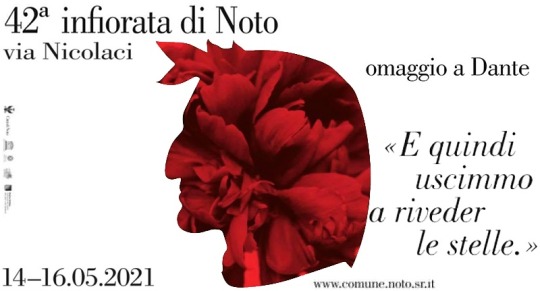
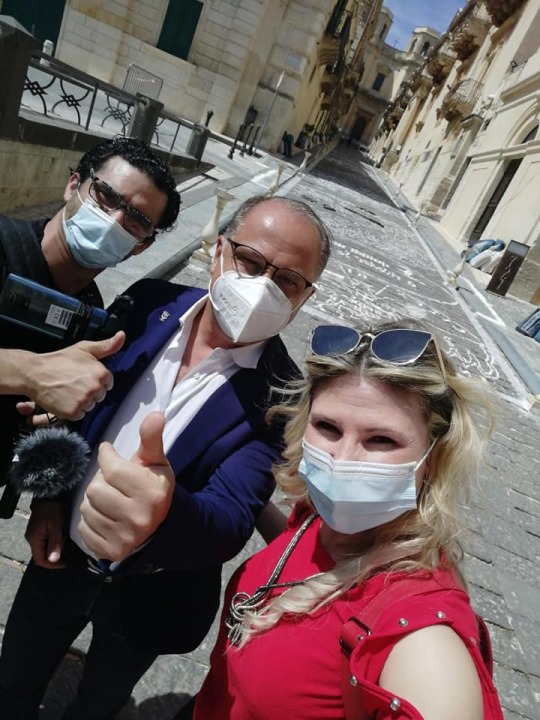
Elena Rodica Rotaru (fashion blogger) insieme ad Andrea Fenu (filmmaker ) Intervista al sindaco di Noto dott. Corrado Bonfanti.

Cattedrale di Noto

Sfilata costumi d’epoca fine ‘’700, associazione corteo barocco di Noto, presidente dott.Corrado Di Lorenzo.
L’origine inglese di questa nobilissima famiglia non impedì a Silvestre di Lorenzo Visconte di Antona del Ducato di Nottuberland di trasferirla in Sicilia, sotto il regno di Re Ruggiero.Tutto ciò si evince da un decreto di concessione del titolo di “Marchese del Castelluccio”, accordato da Re Ferdinando IV nel 1803.I personaggi di questa titolata famiglia furono vari e varie furono le nobilissime gesta che li resero e li rendono, ancor oggi, degni di menzione:un Pietro, Segretario della Regina Costanza;un Nicola, Segretario di Re Manfredi;un Roberto, esimio Giureconsulto, sotto i Re Giacomo e Pietro II d’Aragona;un Giovanni al quale, per il suo valore, gli fu elargito un feudo dal Re Pietro II;un Corrado, Comandante la fortezza di Noto, nonché Gentiluomo di Camera di Re Alfonso;un altro Giovanni, Canonico della Cattedrale di Noto e Cavaliere Cappellano dell’Ordine dei Cavalieri del Santo Sepolcro di Gerusalemme, lodato inoltre per le sue virtù insigni ed illustri; un Lorenzo, primo Marchese del Castelluccio;un Corrado Di Lorenzo e Borgia, Marchese del Castelluccio, Barone di S.Lorenzo, Sammarco, Renda, Granieri, Ciurca, Canali – Cavaliere del Santo Sepolcro di Gerusalemme e Gentiluomo di Camera di Re Ferdinando II.Prendendo come figura di riferimento coloro ai quali ci sentiamo direttamente e fondamentalmente legati, a datare dal dopo-terremoto in poi (1693), esattamente il Nobile Niccolò Di Lorenzo e la sua sposa, la nobildonna Agata Battaglia, ci sentiamo di affermare che i discendenti di questa illustre famiglia, ben presenti ai giorni nostri, costituiscono nota di vanto e di orgoglio, di cui può degnamente fregiarsi la nostra Noto.

Backstage/ dietro le quinte alla sartoria associazione corteo barocco di Noto.
Presidente dotto. Corrado Di Lorenzo, Nuccia Boscarino, Floriana, Salvatore, Andrea Fenu...

Andrea Fenu e Floriana, costumi d’epoca fine ‘’700, associazione corteo del barocco di Noto .
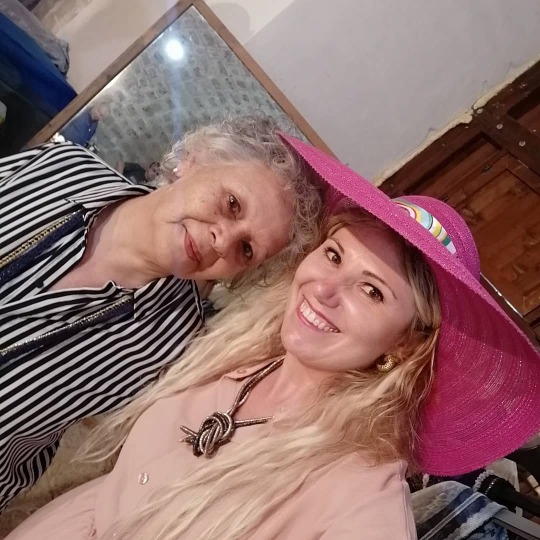
Nuccia Borcarino, responsabile sartoria corteo del barocco di Noto.
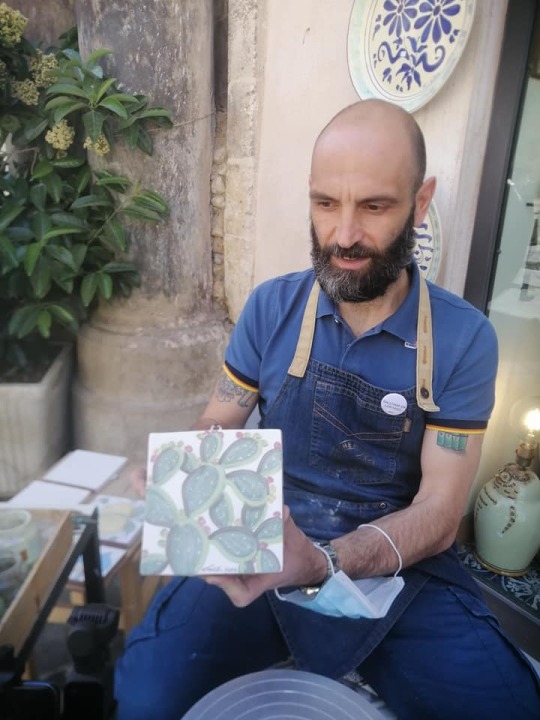
Intervista a Sebastiano Caristia ceramista di Noto.
Gli oggetti e gli elementi d’arendo che trovate in negozio, sono realizzati, presso i nostri laboratori, interamente a mano e secondo le antiche e tradizionali tecniche di lavorazione. S. Caristia.

Bar ‘’A SUD’’ NOTO, barista Corrado Filingeri, chef Valerio Tiralongo ,Corrado Giunta , titolare del bar Valerio Giurdanella .
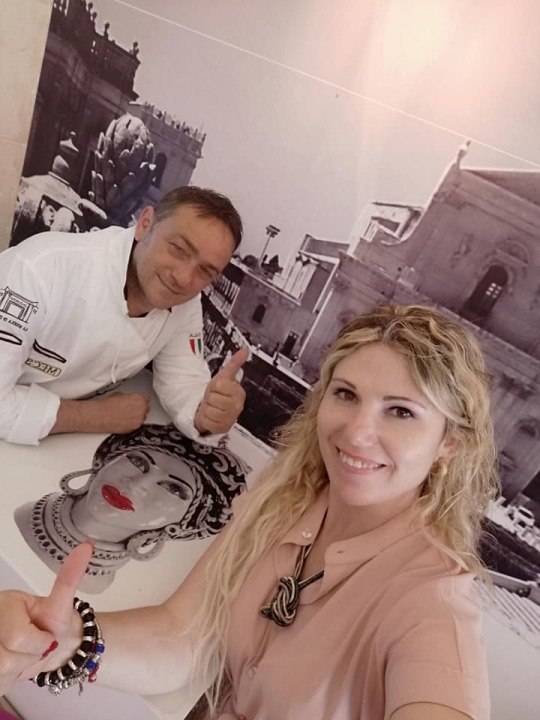
Bar/ gelateria ‘’Caffe Milano’’ di Noto, pasticcere Corrado.
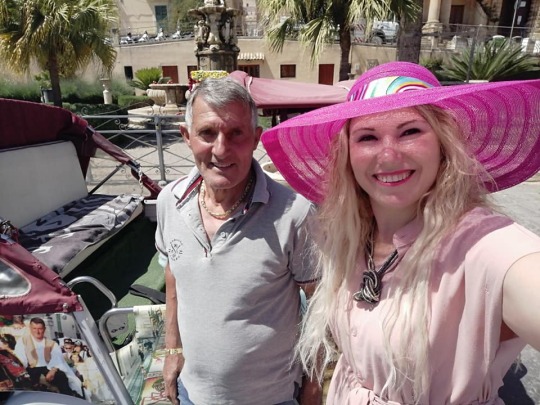
Una gita turistica in piaggio ape calessino a Noto con il maestro Corrado.

Pandataria film -Elena Rodica Rotaru e Andrea Quero ringrazia tanto per organizzazione della produzione documentari a Noto e vicino avv. Franzo Boscarino, titolare della birra Vendicari e tenuta
‘’ Il Biglietto di Vendicari.

Tenuta’’ Il Biglietto’’ di Vendicari.

Pandataria Film Elena Rodica Rotaru (fashion blogger) ringrazia tantissimo per l’ospitalità Tenuta Giasira di Boroli Giovanni e Isabella Focali, novaresi che da tempo ha deciso di vivere a Rosolini. Grazie di cuore a Giorgio figlio della dottoressa Isabella.

Azienda agricola ‘’La Giasira’’.

Tenuta Giasira a Brosolini SR, Sicilia.

Intervista e un bel selfie con il nuovo candidato per il comune di Noto (Siracusa) Sicilia.
dott. Corrado Figura.
Andrea Fenu (cameraman)
Elena Rodica Rotaru ( fashion blogger )

Intervista al nuovo candidato per il comune di Noto (Siracusa). Dott. Corrado Figura. In bocca al lupo!
@likarotarufashion @elenarodicarotaru-blog instagram @elenarodicarotarufficial_79
#graziedicuore❤️#tenuta#giasira#@giovanniboroli @franzoboscarino sindaco noto @CorradoBonfantini infiorata Noto arte fashionblogger @elenarodicarotaru fashion#infioratadinoto2021siracusasiciliafilmdocumentariofashionblogger @elenarodicarotaru
1 note
·
View note
Text
Recensione 1 - “La Storia Infinita” di Michael Ende
Autore: Michael Ende
Titolo originale: Die unendliche Geschichte
Titolo italiano: La Storia Infinita
Anno: 1979
Tipo di opera: Romanzo
Edizione utilizzata per la lettura: Edizione TEA, collana “I grandi della TEA”
Brevi cenni sull’autore: nato nel 1929 e morto nel 1995, di nazionalità tedesca.
La vita di Michael Ende è costellata di eventi più o meno traumatici, soprattutto nei primi anni di vita: ad esempio, nel 1937 morì il suo primo amico, Willie, dal quale lo scrittore trasse anche l’aspetto per il futuro personaggio di Bastiano, protagonista de “La Storia Infinita”. Visse quattordici anni in Italia, a Genzano di Roma, con la prima moglie, morta nel 1985 (l’autore tornò in Germania nel 1983). Compì il suo primo viaggio in Giappone nel 1977 e il secondo nel 1989, dove sposò la seconda moglie; morì di cancro nel 1995.
Curiosità della giovinezza: nel 1945 Michael Ende venne forzatamente arruolato per l'estrema difesa della Germania nazista, ormai prossima alla disfatta totale. Dopo un addestramento fatto di un solo giorno, venne mandato al fronte, dove vide morire tre suoi compagni nei primissimi combattimenti. Il futuro scrittore gettò a terra il fucile e scappò, percorrendo a piedi durante la notte ottanta chilometri, nel tentativo di raggiungere il luogo in cui viveva sua madre; entrò in un’organizzazione antinazista subito dopo, dove rimase sino al termine della guerra.
Altre opere di successo: “Momo”.
Trama dell’opera scelta: Il protagonista è Bastiano, un bambino orfano di madre che non riesce più a comunicare con il padre e che, per fuggire all’ennesima persecuzione scolastica operata da suoi coetanei, si rifugia nella libreria antiquaria del signor Carlo Corrado Coriandoli, che sta leggendo un libro particolare; il bambino si incuriosisce e sottrae l’oggetto al libraio, per poi recarsi nella soffitta della scuola e iniziare a leggere l’appassionante romanzo dal titolo “La Storia Infinita”. Il libro narra le vicende del regno di Fantàsia e della sua sovrana, l’Infanta Imperatrice, minacciati dalla inarrestabile avanzata del “Nulla”.
A questo punto, viene convocato in aiuto il giovane cavaliere Atreiu, il quale si reca presso la Torre d’Avorio dai capi del Regno di Fantàsia, dove viene incaricato di trovare una soluzione al problema che affligge tutti. Da quel momento Atreiu dovrà affrontare, armato soltanto di un medaglione-talismano chiamato Auryn, tutte le varie prove e peripezie che troverà sul suo cammino. Atreiu attraversa Fantàsia e si trova a fronteggiare una serie di imprevisti ed ostacoli; giunge alla conclusione che l’unica possibilità di salvezza è quella di condurre a Fantàsia un essere umano che dia alla sua sovrana un nuovo nome.
Lentamente, Bastiano si lascia sempre più prendere dal romanzo, tanto da rendersi conto di poter influenzare attivamente il proseguimento della vicenda. Capisce di essere lui l’unico in grado di salvare Fantàsia, un luogo che si sta cancellando inghiottito dal Nulla; non si mette però subito in gioco, pensando di non essere all’altezza del compito. La regina si vede dunque costretta a recarsi dal Vecchio della Montagna Vagante, colui che scrive ogni cosa che accade nel regno di Fantàsia, in modo da convincere un umano ad intervenire per salvare il suo regno. Il ragazzo, sfogliando le pagine, si accorge che l’Imperatrice ed il Vecchio della Montagna iniziano a parlare di lui e delle vicende che lo hanno portato a leggere della loro storia.
Il protagonista decide dunque di pronunciare finalmente il nome che ha scelto per l’Imperatrice, per poi venire risucchiato dal libro e catapultato a Fantàsia, dove la sovrana lo incarica di ricreare il regno fantastico ormai ridotto solo ad un granello di sabbia. Con l’Auryn, che riceve in dono dall’Imperatrice, Bastiano inizia la sua avventura a Fantàsia e il suo compito è quello di ricreare il regno attraverso i suoi desideri. Solo Atreiu e il fortunadrago Fucùr si rendono presto conto che, ad ogni desiderio che egli esprime, perde un ricordo legato alla sua vita da umano; se il ragazzo dovesse finire i suoi ricordi non potrà più esprimere desideri, rimanendo intrappolato nel regno di Fantàsia per sempre.
Infatti Bastiano ricorda solo il proprio nome e, con l’aiuto di Atreiu, accede alle Acque della Vita, dove si immerge – per poi ritrovarsi nella soffitta della scuola e tornare a casa, quando saranno i suoi amici a portare a termine il suo compito.
A quel punto Bastiano si reca nella libreria per restituire il libro e racconta tutta la storia a Cordiandoli, che però finge di non saperne niente.
Stile: Lo stile è scorrevole e lineare, semplice da seguire anche per i più giovani, almeno nella traduzione italiana; il racconto viene portato avanti con la cadenza tipica dei racconti fantastici e ben si adatta ad un pensiero semplice, senza iperboli superflue.
Commento alla storia: “La storia Infinita” è stata la seconda storia di cui ho visto prima il film in televisione, per poi leggerne il libro (la prima storia è stata quella di Peter Pan con “Hook - Capitano Uncino” nella mirabile interpretazione di Robin Williams, ma non è questa la sede per parlarne). Il film che vidi da bambina mi aveva particolarmente colpita e leggerne il libro mi ha fatto tornare indietro nel tempo: ho pianto di nuovo alla morte di Artax, il cavallo di Atreiu (uno dei due protagonisti), mi sono sentita scaldare il cuore dall’intervento di Fùcur nelle Paludi della Tristezza, mi sono spaventata quanto Bastiano (il protagonista principale) mentre leggevo di Mork.
Ma affrontare questo racconto con una mente più adulta mi ha fatto comprendere anche il suo fine: non solo la volontà di Ende di far comprendere cosa sia la “Fantasia” e perché sia importante, soprattutto per i bambini, che si trovano, soprattutto ai nostri tempi, in continuo contrasto con il “Nulla”, ma anche quanto sia necessario capire se stessi. Quando lo Specchio Magico, al cancello della Seconda Porta per raggiungere l’Oracolo, riflette l’immagine di Atreiu, del suo vero io, rivelandogli un ragazzino emaciato nella soffitta di una scuola, che altri non è che Bastiano, che legge di se stesso, si capisce come il vero io di ognuno di noi non sia quello che il nostro specchio ogni mattina riflette, con la nostra immagine di noi da appena svegli, ma sia quello del nostro inconscio, che vive grandi avventure a nostra insaputa. Chi ancora non l’ha capito, è ridotto come quegli adulti che pensano a tutto e non pensano a niente, portando avanti la loro vita nel grigiore più totale.
Qui sta la magia della “storia infinita”: è un cerchio che si apre con Bastiano che ruba il libro dal negozio del Titolare Carlo Corrado Coriandoli Antiquariato e si chiude con Bastiano che lo restituisce al Titolare Carlo Corrado Coriandoli Antiquariato, che tuttavia non ricorda di averlo posseduto; il cerchio infinito si apre e si chiude con noi lettori attaccati alla pagina del libro, con noi che siamo e non siamo quel bambino di nome Bastiano.
VeronicaSaeko

#die unendliche geschichte#la storia infinita#recensione#review#italian review#book#literature#michael ende#veronicasaeko#saekothen
1 note
·
View note